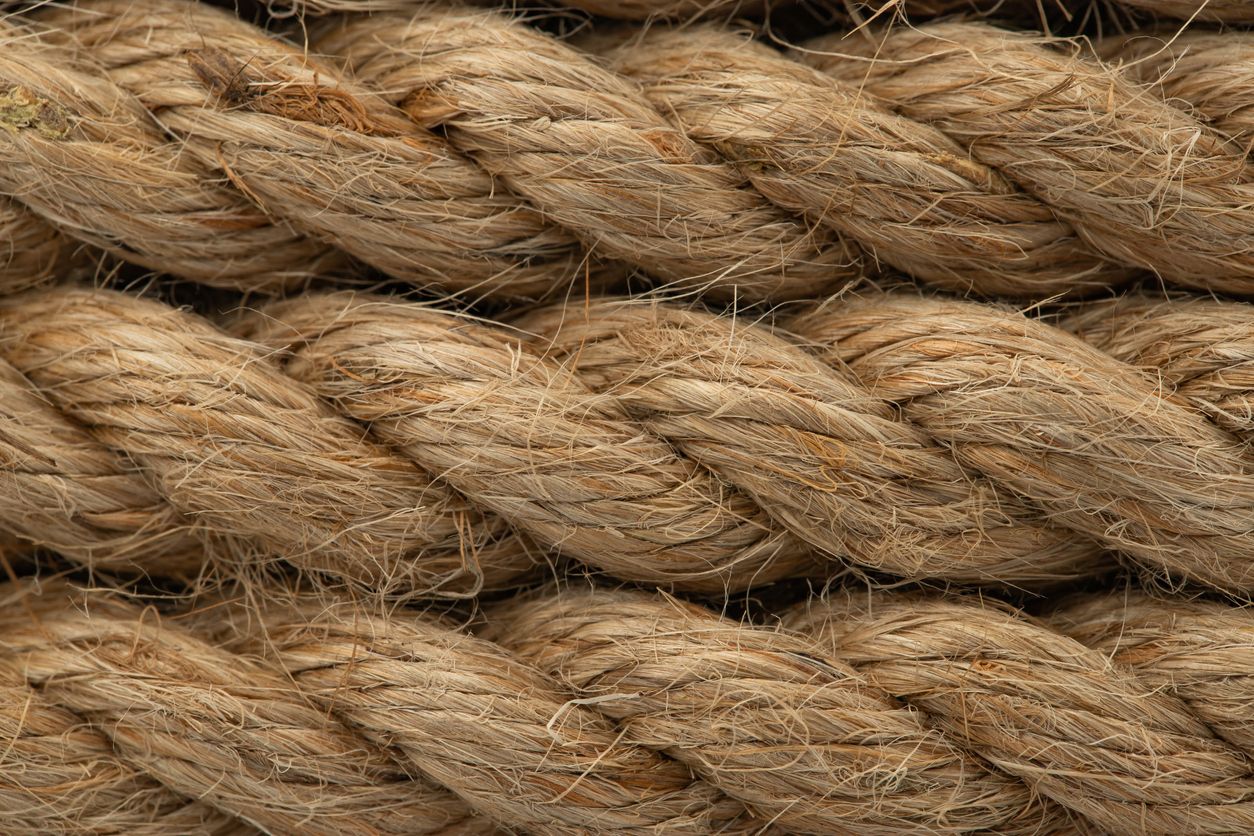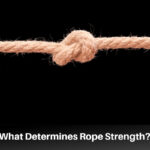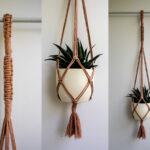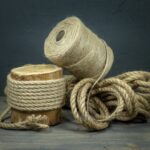Hemp rope comes from the natural fibers of the hemp plant. Hemp is native to Central Asia; China was the first to grow the plant and make it into rope.
Hemp fibers are ideal for rope because they are durable, strong, and mold and UV resistant. They don’t stretch but are still flexible. Hemp is cheap, so it’s an excellent alternative to expensive synthetics. It’s also better for the environment.

Historically, hemp is important in the city of Calatayud, a municipality in Spain. Rope-makers are revered in the area where they traditionally make rope. Traditional rope-making is a long process. It requires separating the fibers, breaking them, and twisting them by hand. Three rope-makers must work together to form the rope with the help of a simple spinning machine.
Hemp rope is one of the strongest natural ropes; consult the tensile strength chart below.
Due to its weather-resistant properties and durability, hemp rope has many uses, including:
- Boating & fishing
- Rock climbing & mountaineering
- Logging
- Gym use & military training
- Decoration
- Jewelry
- Clothing
- Smoking
Consult the chart below to see the differences between hemp and other natural ropes.
What Is Hemp Rope?
Hemp ropes come from natural materials from the hemp plant. The hemp fibers surrounding the inner stalk of the plant are what make up hemp cordage. After processing the fibers, laborers twist or braid the long fibers into rope.
Hemp is the ideal material to make into rope. The plants grow quickly in less-than-ideal situations. One acre of hemp can produce up to 75 tons of dry material a year. Hemp doesn’t need fertilizer, and it’s used to living in nutrient-poor soil. It’s great for the environment, too, because it absorbs copious amounts of CO2.
These ropes are more sustainable than synthetic ropes like nylon, polyester, and polypropylene. They are less durable than most synthetic ropes. Yet, they are more durable than many other natural ropes. Hemp ropes have considerable breaking strength and are absorbent and insulating. Plus, they don’t stretch, although they are flexible.
Hemp is a good option for those on a budget because it’s cheap, especially compared to synthetic ropes.
Does Hemp Rope Rot?
Hemp is one of the best natural ropes because it’s resistant to mold and mildew. It may begin to rot after extended periods of exposure. Still, it is less likely to rot than other natural rope materials, like cotton.
Most users get several years out of their hemp ropes, even in harsh conditions. Like synthetic ropes, hemp rope can take a beating and still remain strong.
Hemp rope is also resistant to damaging UV rays, so it’s not as likely to break down in the sun.
Your hemp rope will eventually begin to break down. Still, it’s biodegradable and eco-friendly, so the environment suffers no ill effects.
Natural ropes, like jute, are often treated with chemicals to prolong their lifespan. Chemical treatment is rare with hemp rope. Still, hemp fibers are resistant to chemical damage. So, if it’s necessary to use hemp rope around chemicals, the rope won’t break down.
The History Of Hemp Rope
Humans have been using hemp rope for centuries. The ancient Chinese people were the first to produce ropes. They were also the first to create ropes from hemp fibers.
Throughout history, sailors were the ones to use hemp rope the most. They found it valuable because of its UV and rot-resistant properties. The rope’s primary purpose was to secure items on the boats. Hemp ropes were also popular for creating fishing nets.
Hemp rope was significant in the City of Calatayud. Its importance is cataloged in the Book of Acts of the Guild of San Pascual Bailón de Los Sogueros. The book shows that the rope-making trade had invaluable importance in the city. It also shows that many men worked in the trade.
To enter the brotherhood, men must pass an exam showing their rope-making skill.
On May 18 of every year, the people of Bilbao even hold a celebration where they dance with the brotherhood. The celebration is in honor of San Pascual and the rope makers of the city.
Our prehistoric ancestors also used hemp rope for these purposes:
- Carrying/lifting items
- Climbing
- Hunting
- Basket-weaving
- Sports
- Construction
How To Make Hemp Rope
Today, hemp rope making is still valuable in the City of Calatayud where they make the rope by hand.
The Beginning Processes
First, the rope makers extract the fibers from the hemp plant and dry them.
Second, they crush the dried grass inside a large, wooden “gear.” Crushing the grass separates the fibers from the rest of the plant.
Third, rope makers drape the fibers over a large piece of wood and hit the fibers with a wooden “sword.” The process is called “spreading.” It separates any remaining straw stuck to the fibers.
Fourth, the rope maker puts the hemp through the process of “raking.” Raking separates the individual fibers by their specific qualities. The rope maker passes the strands of fiber through tall, thin metal spikes. Dozens of spikes sit in a cluster, like a kind of comb.
The fibers pass through the cluster continuously. The shorter strands of lesser quality, called “Levada,” get stuck inside the cluster. The longer, higher-quality fibers remain in the rope-maker’s hand. The high-quality strands are then tied into a loose ball called a “pineapple.”
Making Threads
Now, the rope-maker can begin making the ropes.
First, they must “fix” the fibers around their waist like a girdle. Holding the fibers to their waist helps the rope-maker keep a good grip on the materials.
Second, the rope-maker begins to feed the hemp fibers into the spinning machine. They do so with a wet cloth and a steady hand. A second person must spin the machine with a hand crank.
The rope-maker walks backward slowly. They thread the fibers through their fingers and into the machine. They use their fingers as a gauge for how thick to make the threads; the process is called “clarifying.” At the same time, the spinner must keep a steady rhythm. Together, the rope-maker and spinner create even strands of equal quality.
Third, as the rope-maker walks backward, there are posts with spokes at even intervals. The rope-maker lays the thread between each spoke. They do this so individual strands don’t intertwine and the fibers don’t have to lay on the dirty ground.
Making Cords
To make a rope, the rope-maker must use four cords comprising four threads. After making four threads, they “cork” them to make a cord. Making a cord requires three people.
First, The first person holds the “ferrete,” or hook, which maintains tension. The second person combines the four threads into one. They walk forward, combining the four threads with the wet cloth. The third person, the spinner, continues turning the wheel to maintain torsional movement. The first person walks forward with their hook as the length of the rope decreases.
After they make the first cord, the rope-makers must repeat the process three times. In the end, they will have made four cords.
Second, they twist the four threads into a cord. The twisting process of the threads into cord is similar to how they made the threads. The three rope-makers follow the same method to twist the threads into thicker cords. While doing so, they must take care to twist the threads so they are equal.
As one of the threads goes slack, they stop spinning the tight one. They continue spinning the slack thread until all threads are of equal tension again.
Third, they must stretch the cords. They place two heavy metal posts in the ground, far apart from one another. Then they tie one end of the cord to the first post. Next, the rope-maker pulls on the opposite, stretching it and tying it to the second post.
Fourth, they “pass” the cord, rubbing coarse mesh against the length of the cord. The cord is wetted at the same time. Doing so removes any remaining hemp and thins the cords. Such a process keeps the cords fine and prevents fraying.
Fifth, they pass a “dry” through the cords. A “dry” is a rope wound between the cords and dragged along their length. It removes any impurities left on the cords and leaves them polished. Next, the cords are left to dry.
Making Rope
Next, the cords go through a “corking” process to create rope. A corking machine holds the cords to hold the weight and tension of the rope during the process.
Second, the process of making the rope is like that of making the cords. The difference is in the rope’s thickness and the hook’s size and “fustre.”
Third, after going through the same process as before, the rope is ready for “folding.” The folding machine spins the rope into a bundle, which is tied together with a string.
After all this work, the rope is finally finished.
What Is The Tensile Strength Of Hemp Rope?
There are two common ways to measure a rope’s strength: tensile and breaking strength.
The tensile and breaking strengths refer to the load a rope can handle before breaking. Yet, tensile strength is not very useful for the average user.
Tensile strength is measured in controlled laboratory conditions on a brand-new rope. It shows when a rope will break under ideal conditions. So, the tensile strength is often much higher than the breaking strength.
Breaking strength considers normal working conditions that a rope might be subjected to. It considers water, UV, and chemical exposure. It considers the types and number of knots users may tie into the rope. Anything that may weaken the rope is considered when calculating the breaking strength. So, the breaking strength is more realistic than the tensile strength.
The breaking strength of hemp rope is high. It’s weaker than manila rope but stronger than other natural ropes like cotton, jute, and sisal. Yet, there isn’t much information on the average breaking strength of hemp rope. The packaging on the rope should include the breaking strength. So, be sure to check that out before buying.
Tensile Strength of 3-Strand Twisted Hemp Rope
| Diameter (mm) | Tensile Strength (lbs) |
| 6 | 627 |
| 8 | 1,122 |
| 10 | 1,749 |
| 12 | 2,607 |
| 16 | 4,389 |
| 20 | 6,732 |
| 24 | 9,581 |
| 28 | 13,057 |
| 30 | 14,993 |
Precautions
Always handle your rope well below its breaking strength. The breaking strength is an estimate, not an accurate calculation. The actual breaking strength of each rope varies and may be less or more than the calculated number. To be safe, you should always work below the breaking strength to avoid injury.
What Are The Uses Of Hemp Rope?
Due to its strength, durability, and versatility, hemp rope has many common uses.
Boating & Fishing
Hemp isn’t as common on boats and ships anymore with the invention of synthetic materials. Still, boaters use hemp because of its mold and UV-resistant qualities.
Some uses of hemp rope on boats include:
- Mooring
- Sailing ropes
- Anchor rods
- Anchor lines
Rock Climbing & Mountaineering
Hemp rope is popular for outdoor activities like rock climbing and mountaineering. Hemp is durable and can handle a lot of wear and tear. It’s also water, mold, and UV-resistant, so it’s not likely to break down in the elements.
Logging
Hemp rope’s mold, UV, and abrasion-resistant qualities make it ideal for logging.
Gym Use & Military Training
Natural hemp ropes are common in gyms for weight training, such as in CrossFit. The heavy ropes are good alternatives to traditional weights. They offer better grip, but are just as heavy.
For the same reasons, hemp rope is common in military training. Hemp rope’s weather-resistant properties make it especially useful for military operations.
Decoration
Using ropes for decorative purposes is gaining popularity, especially macrame. Since hemp rope is UV resistant, it doesn’t fade in the sun. It’s also mold-resistant. So, it’s suitable for outdoor decoration such as decorative fencing.
Artists and designers create many home decorations from hemp rope, including:
- Wall hangings
- Plant pot holders
- Rugs
- Frames
Clothing
Hemp rope sandals are popular for beach use. They hold up well because of their UV and mold-resistant qualities. A hemp rope belt is helpful for the same reasons and adds a nautical feeling to any outfit.
It’s also possible to dye hemp rope, making it even more popular for clothing.
Jewelry
A hemp rope necklace is one example of popular jewelry made from hemp. Bracelets comprising hemp rope are also gaining popularity.
Hemp Rope For Smoking
Some smokers use hemp wicks for smoking rather than traditional lighters and matches. Hemp wicks come from spun hemp fibers. Then, the wick is dipped in beeswax and sold as a large spool.
Hemp VS Other Natural Ropes
Consult this chart to compare hemp rope with other nature ropes:
Comparison Of Natural Ropes
| Jute | Manila | Cotton | Hemp | Sisal | |
| Strength | Fair | Good | Weak | Fair | Fair |
| Shock Absorbency | Poor | Poor | Poor | Poor | Poor |
| Elasticity | Poor | Poor | Poor | Poor | Poor |
| Floats | No | No | No | No | No |
| Water Absorption | 100% | 100% | 100% | 100% | 100% |
| Shrinks When Wet | Yes | Yes | Yes | Yes | Yes |
| Resistant To UV | Good | Good | Good | Good | Good |
FAQs
Where To Buy Hemp Rope Near Me
Hemp rope is common in most stores that sell natural and synthetic ropes. They can be bought in-person or online at a variety of stores.
Some places where hemp rope is available include:
- Home Depot
- Lowe’s
- Ravenox
- ULINE
- Walmart
- Amazon
- Tractor Supply Co.
- Michael’s
Is Hemp Rope Safe For Dogs?
Most experts agree that rope toys are not safe for dogs. Some say giving your dog rope toys is okay as long as you supervise them, but watching your dog won’t eliminate risks.
Many dog toys are made from hemp cordage, but that doesn’t mean it’s safe for dogs. Dogs are sneaky, and they love to chew. They may manage to swallow a few strands of rope without you realizing it, even if you never take your eyes off them.
Ingested strands are dangerous for dogs, cats, birds, and other pets. They can cause blockages in the stomach and intestines that are difficult to remove. Pets often must go through dangerous surgery, and vets aren’t always able to save them.
It’s best to avoid rope toys, but if you decide to use them, take caution. Never allow an unsupervised dog to play with rope, and never let them chew on it. Throw away any rope toys that begin fraying or showing other signs of damage.
Is Manila Rope The Same As Hemp?
Manila and hemp rope are often confused because they are both referred to as “hemp.” Manila comes from the fibers of the leaves of the abaca plant, otherwise known as “manila hemp.” Manila got the label “hemp” because hemp has always been one of the most popular materials used to make rope. Non-natives were unfamiliar with the abaca plant and assumed the plants were hemp as well.
Does Hemp Rope Shrink When Wet?
Hemp fibers shrink when wet, like all natural rope fibers. They shrink the most the first time they get wet. So, many manufacturers “pre-shrink” their ropes before selling them. Shrinkage is minimal and barely noticeable after the first time.
Can You Use Hemp Rope For Deer?
It is common for outdoors people to use hemp rope for deer hunting. A scrape is a spot where deer naturally spread their scent by pawing the ground and licking branches. They make these spots to show they’re ready to breed or to mark their territory.
Some hunters make “mock” deer scrapes using hemp rope. Rather than providing a branch for the deer to scratch themselves on, the hunters give a hemp rope. Hemp ropes are full of scents unknown to the deer. So, they find it irresistible and scrape themselves against it.
Hunters use this tactic to figure out which bucks are in the area to make hunting easier.




